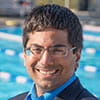Spring Nationals Gives Two USMS Swimmers a Chance to Overcome Setbacks
Brad Jones and Janine Yoder face difficulties as soon as they get into the water
Brad Jones feels a wave of dizziness about 100 yards into his warm-up when he swims, something the Puget Sound Masters swimmer pushes through for the rest of practice.
Janine Yoder can’t swim more than 20 minutes because of a car crash last year, one that forces the Kidz Aquatic Masters Swim Club swimmer to drag her right foot when she walks and has left her with a bulging disc in her neck.
Despite facing conditions that limit their training as soon as they jump into the water, the two were among the 2,000-plus people who competed in the 2017 Nationwide U.S. Masters Swimming Spring National Championship in Riverside, Calif., last weekend.
“I think one thing I’ve learned is that the good things in life come from seeking what’s uncomfortable sometimes,” the 51-year-old Jones says. “It’s been incredibly rewarding for me to be within Masters Swimming, to be swimming races again. It feels good.”
Jones received a diagnosis of acoustic neuroma (having a benign tumor on the main nerve between the inner ear and brain) in 1999 and had the tumor removed through radiation in 2003 after his doctor monitored its growth in the interim.
But the treatment damaged the nerve, causing Jones to immediately lose hearing in his left ear and experience a progressively worse sense of balance over a year’s time. He recalls struggling through yoga and bumping into walls while walking down hallways.
The damage also led to the dizzy spells that nearly ended Jones’s return to swimming.
He didn’t swim much after competing for Penn State but was slowly drawn back into the sport. He began coaching the Bellingham (Wash.) Bay Swim Team, and his friends persuaded him after several years to join the local Masters group in October 2015. But the comeback lasted just two months because of the dizziness.
“Getting back in the water did feel good,” Jones says. “I wasn’t ready to give it up.”
Jones began wearing an ear plug in his right ear and focused on keeping his head still underwater on freestyle, the stroke that gave him the most trouble because of its rotational breathing. This work helped improve his technique.
The effort paid off. Jones, who swam the 100- and 400-yard individual medleys, the 100-yard butterfly, and several relays at Spring Nationals, hasn’t experienced much trouble with his dizzy spells since making the adjustments.
“You would not know unless he told you,” says Linda Hegeberg, who swims with Jones on the Bellingham Masters Swim Club workout group. “After a while after I swam with him, he mentioned, ‘Oh, sometimes if I don’t answer your question, it’s because I can’t hear out of one ear because I had a brain tumor.’ It’s like, ‘Huh?’
“He has never sat out, he has never complained. He’s always willing to be the lane leader and keep us going in the direction we’re supposed to be going.”
Yoder does the same for her Masters club as a USMS-certified Level 3 coach, work she balances with swimming and running Kidz Aquatic, a learn-to-swim program for children and adults in Canoga Park, Calif., which is about 30 miles northwest of Los Angeles.
Michelle Kobrin loves having Yoder as a coach for the Kidz Aquatic Masters Swim Club. Kobrin left in early March to bike from Vancouver, Canada, to the Mexican border, a trip of more than 1,200 miles, and Yoder surprised her with a going-away party.
“That’s Janine and how she looks at all of us,” Kobrin says. “She appreciates us individually so much that she wants to celebrate each of our accomplishments with us. She feels bad when she brings new people in and can’t keep them to stay.
“She’s probably the warmest-hearted, most giving person that I’ve met in a long time.”
Kobrin says Yoder’s personality didn’t change after her car crash in March 2016, one that Yoder says causes her back pain whenever she kicks too much with her left leg. The first few laps of each practice stretches her back out, the 32-year-old Yoder says, before spasms force her to stop swimming after about 15 or 20 minutes.
“I know I’m hurting, but I’m pushing through it,” she says. “One of the lifeguards helps me out of the pool, and after I take the spasm pill, I’m OK to drive home.”
Yoder describes her swimming style as just getting into the water and going, saying she doesn’t worry about warming up or counting how many yards she does. She signed up for the 50- and 100-yard freestyles at Spring Nationals with the goal of not finishing last.
“I didn’t want to push myself too much,” Yoder says, laughing.
Still, she pushed herself enough to compete in both of those events because of what swimming means to her.
“I’ve been swimming since I was little,” she says. “I’ve always been a part of swimming.”
Categories:
- Human Interest
- Events















